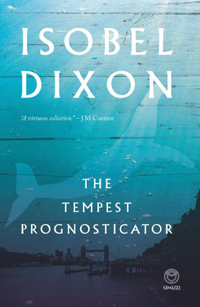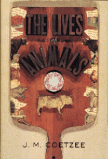The Tempest Prognosticator by Isobel Dixon, Cape Town, Umuzi, 2011.

The cover of this slim volume of evocative poems entices the reader into a strange world: broad planks of wood in the foreground reveal the imprint of a misshapen porpoise creature; translucent bubbles rise, perhaps from a darkened, submarine London. Even to attempt to categorise the surrealism of these images seems clumsy, but they serve as a fitting invitation to the world of The Tempest Prognosticator, which encompasses representations of the city and the natural world, and the lives of beings who straddle these spheres, even as it engages with the drama of interspecies connections, whether through the embodied nonhuman animal or her presence in art, literature or science.
J.M. Coetzee, who rightly praises these poems as a “virtuoso collection”, has Elizabeth Costello in The Lives of Animals speak of poetry about animals. She favours poems which are a “record of engagement” with an animal rather than those

which have animals standing for an idea about human characteristics (1999:51). Yet Dixon’s poetry goes beyond such binarism. The epigraph from Henry James in the frontispiece of The Tempest Prognosticator gestures to the impossibility of differentiating so confidently between the embodied animal and the symbolism s/he carries: “Cats and monkeys; monkeys and cats; all human life is there.” If monkeys and cats seem to enact the human metonymically, human subjectivity is also intertwined with that of the nonhuman, in the primate and feline spaces. In Dixon’s poetry the natural world is never a place that is outside of the human sphere; nature and culture are interdependent. The poems are redolent of Donna Haraway’s notion of “multispecies knots” (2008:35) in which a human “become[s] with” an animal (2008: 35).
In “The Whiteness of the Whale”, the whale who swam up the Thames is located within a literature of whales: Moby Dick, Jonah, the Leviathan; but also within a history of English whales, one who was regarded as a sign of “Cromwell’s imminent demise”, and another who was a “stranded ancestor” purchased by a Quaker. Yet this whale is of our time: encountering “crowds gawking from the banks, / a sentimental audience, News24.com”. The whale’s search for any ancestry as a reason for his presence seems less likely than the apparently off-handed ecological import:
Perhaps, cresting the surface, blowing to excited cries,
the dirty water spouted out his warning of the melting ice.
In other poems a light, affectionate humour is deployed in relation to the natural world. Often the denizens of nature are not merely our kin; humans themselves “become with” animals or birds. In “Peacocks in the Boar Garden” the Italian students metamorphose into an avian display, each with pride in “his bristling crest”, “quiff” and “muscled chest”. But the last word is given to the stolid statue of a boar who “knows, by his snout, he is the stouter beast”. In “Toktokkie” a beetle, a “shined up desert Fred Astaire”, is assigned performative agency in his quest for “some lovely darkling beetle girl”.
Primates feature especially in this collection, with human and nonhuman identities overlaid. In the poignantly playful “You, Me and the Orang-utan”, the speaker dismisses her human lover, having fallen in love with the Orang-utan not just for his sensitivity (“gentle, nurturing”) but for the physicality of “his supple lips, those melancholy eyes / the noble furrowed brow” and for his rarity. While she admits the hopelessness of her passion, she is enthralled: “I lie here, burning, on our bed, and think of Borneo.” In “Postcard from the Colonies” the map of Africa is an extension of the monkey’s embodiment itself as the “long-faced monkey”, and his companion seems implicated in European imperialism and its plundering of the continent.
A couple of the poems about birds recall Ted Hughes in their depiction of the dramatic cruelty of nature. “Upupa Epops”, addressed to the hoopoe, celebrates the “[s]carce-passage migrant” as well as representing the violence he metes out to the insect world. In “The Parliament of Gulls” we see the remains of “gutted baby sharks, / eye sockets scooped-out / holes in sheeted flesh, / a spectral gathering of Ku Klux fish”. If both hoopoe and seagulls are portrayed in relation to potentially human characteristics, these birds are never denigrated or relegated to humans manqué. Dixon writes with affection and with respect for the hoepoe who is, variously, a “vaudevillean”, a “prophet”, a “dandy priest”; in addition, biological facts about the bird’s behaviour in his habitat and in nesting are included.
The tone of “Requiem”, which narrates the demise and reconstitution of Damien Hirst’s artwork using sharks, is deeply critical of the ethics entailed in these representations. It also mocks the artistic hubris of attempting to contradict death. Yet both speaker and reader are implicated in the reduction of the predator to a “glass-bound sea-beast” with “its lurking menace stilled / for us to gawp at”. Tragically, the replacement Queensland shark is transported from tropical waters “to cold formaldehyde … once lone marauder, now a marinading fish, bizarrely / acupunctured by the rubber suited / men”. Dixon’s diction is economically cutting, the rhymes deftly underscoring her critique of artists, scientists and art collectors who are implicated in the aesthetic objectification of nonhuman bodies.
A more felicitous connection between art and the natural world occurs in “Silking the Spider”. This enchanting poem is permeated by an aura of mystique and magic, yet, as the notes tell us, the outcome of this poem is factual, with the harvesting of the silken cobwebs of the golden orb spider resulting in a magnificent tapestry now in the Tate Modern. The speaker, in taut, condensed descriptions, wonders if the spider collector’s dream
… of leagues of liquid spiralling inside
a pitch-and-primrose abdomen, slow fluid
zig-zagging to tensile radiance, rare Madagascar gold.
Dixon’s poetry defamiliarises the way we see our environs even as it enlivens or shifts the imagery to which we are accustomed. In “Paradox” she has the “heart leap, frog- / like landing with a soggy plop”. In such a context love can only “make a mockery of us” as we “lie awake / at night and croak and croak for it”. In “Valentine” she continues this undermining strategy. The poem is worth quoting in full:
sweet fallacy the heart
this heaving muscle glistens darkly
something like a toad
When the speaker meets a frog on the pavement in “Familiar”, it seems an organic continuation of these images.
Love and sensuality recur throughout the collection, often through what J.M. Coetzee refers to on the dust-jacket as “mordant ventriloquizings of the female self”. The poems, “Trappings”, “King Kong Déjà vu”, “Housewifery” and the prize-winning “Usury”, among others, come to mind in this regard. The whimsical “The Desserted Patisserie” skilfully interweaves pastries and the lovers: “the knotted bodies’ / pastry twist, / a coupling crystallised” as they attain “their just desserts”, while “Root Verses” celebrates the delights of exotic vegetables and, even, their nascent peacefulness.
Attempting to convey the rich expansiveness of The Tempest Prognosticator in a review is barely possible, but a couple of other aspects of the collection demand mention. One of these is the way the environment connects to a strong sense of human destructive culpability, as well as the arbitrariness of language and naming, which may be entirely heartless and sinister. The individual human tragedy depicted in “Into the Wild” points to “[t]hese traces that we leave / of all we’ve saved or slain”. Such violence is extended in “Mountain War Time”, which collocates the eruption of Mount Saint Helens with the “promised rain of ruin” engineered by the Sumo Bomb, even as “Fat Man”, the familiar and even fond name for the bomb, troubles the reader. And if plant life is resurgent around the volcano, the atom bomb has irrevocably devastated interdependent bodies, nature and a city: “molten kimono flowers singed to skin, / a city threshed and sewn with blossoms fissioning.”
Dixon’s poetry also brings to mind (or this one at least) a strong connection with John Donne’s sense of new spaces, astronomy and science. “Robinson is Space” invites the explorer back to earth via places and names which echo earlier geographies and enlightenment science. “The Tempest Prognosticator” describes Dr Merryweather’s “Ingenious carousel”, which has leeches primed to set off a bell to foretell a storm when they climb their jars in response to “altered atmosphere”. In both poems science, or would-be science, merges with the fantastical and the magical; in “First Faints” on the other hand, science connects with embodiment and sensuality.
Dixon’s mastery of language, imagery, rhyme and cadence are exceptional. The scope of the collection is various and extensive – and always beguiling. Read it!
References
Coetzee, JM. 1999. The Lives of Animals. Edited and with an introduction by Amy Gutmann. The University Center for Human Values Series. Amy Gutmann Editor. Princeton, NJ: Princeton University Press.
Haraway, Donna. 2008. When Species Meet. Posthumanities, Volume 3. Cary Wolfe, Series Editor. Minneapolis: University of Minnesota Press.
 SLiPStellenbosch Literary Project
SLiPStellenbosch Literary Project